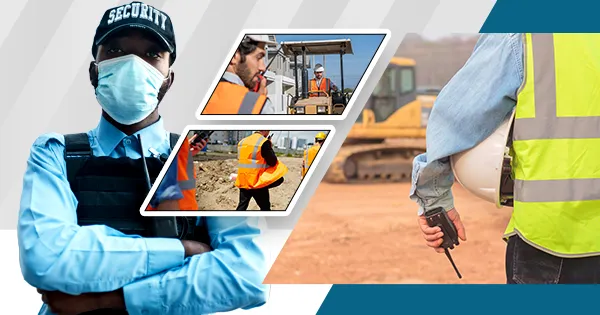Deep cleaning is an essential aspect of maintaining a safe and productive construction site. Construction sites are often filled with potential hazards and health risks, making it crucial to prioritise cleanliness and organisation. Deep cleaning not only helps eliminate these hazards but also improves productivity and enhances the reputation of the construction project. In this article, we will explore the importance of deep cleaning in construction sites, discuss techniques and best practices, provide a step-by-step guide to deep cleaning, and highlight the specific benefits in terms of safety, productivity, and reputation.
The Importance of Deep Cleaning in Construction Sites
Construction sites are known for their potential hazards and health risks. From dust and debris to hazardous materials and equipment, numerous dangers can pose a threat to the safety of workers. Deep cleaning plays a vital role in eliminating these hazards and creating a safer work environment. By removing dust, debris, and other contaminants, deep cleaning helps reduce the risk of accidents, injuries, and illnesses.
In addition to safety concerns, deep cleaning also contributes to the overall well-being of workers. Construction sites can be dusty and dirty environments, which can lead to respiratory issues and other health problems. Regular deep cleaning helps improve air quality by removing dust particles and allergens, creating a healthier work environment for everyone involved.
Restoring Order: The Key to Efficiency in Construction Projects
Maintaining a clean and organised construction site is crucial for ensuring efficiency and productivity. A cluttered site can lead to delays, accidents, and mistakes that can significantly impact the progress of the project. Deep cleaning plays a key role in restoring order to the site and creating an environment that promotes efficiency.
A clean and organised construction site allows workers to easily locate tools, equipment, and materials, reducing time wasted searching for items. It also helps prevent accidents caused by tripping over clutter or misplaced objects. By implementing proper storage systems and regularly deep cleaning the site, construction projects can run smoothly and efficiently.
The Art of Deep Cleaning: Techniques and Best Practices
Deep cleaning of a construction site requires specific techniques and best practices to ensure effective results. One of the first steps is to assess the site and identify areas that require deep cleaning. This can include floors, walls, equipment, and storage areas. Once the areas have been identified, it is important to gather the necessary cleaning products and equipment.
When deep cleaning a construction site, it is crucial to use the right cleaning products and equipment for each specific task. For example, heavy-duty degreasers may be needed for cleaning equipment, while specialised cleaners may be required for removing stains from walls or floors. It is also important to follow safety guidelines when using cleaning products and equipment to protect both workers and the environment.
Reviving Construction Sites: A Step-by-Step Guide to Deep Cleaning
Deep cleaning a construction site can be a daunting task, but with a step-by-step guide, it becomes more manageable. Here is a general guide on how to deep clean a construction site:
✔️ Assess the Site
Start by assessing the entire site and identifying areas that require deep cleaning. This can include floors, walls, equipment, storage areas, and common areas.
✔️ Gather the Necessary Tools and Equipment
Depending on the specific tasks involved in deep cleaning, gather the appropriate tools and equipment. This may include brooms, mops, vacuum cleaners, pressure washers, degreasers, and specialised cleaners.
✔️ Remove Debris and Clutter
Begin by removing any debris or clutter from the site. This includes sweeping or vacuuming floors, clearing out storage areas, and organising tools and equipment.
✔️ Clean Floors and Walls
Use appropriate cleaning products and techniques to clean floors and walls. This may involve mopping or scrubbing floors, removing stains from walls, and ensuring all surfaces are thoroughly cleaned.
✔️ Cleaning Equipment and Machinery
Deep cleaning of all equipment and machinery using the appropriate cleaning products. This may involve degreasing, removing dirt and grime, and ensuring all moving parts are properly lubricated.
✔️ Clean Storage Areas
Organise and clean storage areas, ensuring that all items are properly stored and labelled. Remove any dust or debris from shelves or cabinets.
✔️ Dispose of Waste Properly
Ensure that all waste generated during the deep cleaning process is disposed of properly. This may involve separating recyclable materials, hazardous waste, and general waste.
✔️ Maintain Cleanliness
Implement a regular cleaning schedule to maintain the cleanliness of the construction site. This may include daily or weekly tasks such as sweeping, mopping, and organising.
Benefits of Deep Cleaning in Construction: Safety, Productivity, and Reputation
Deep cleaning of construction sites offers numerous benefits in terms of safety, productivity, and reputation. Firstly, deep cleaning helps create a safer work environment by eliminating potential hazards and health risks. By removing dust, debris, and other contaminants, deep cleaning reduces the risk of accidents, injuries, and illnesses.
Secondly, deep cleaning improves productivity by creating an organised and efficient work environment. The clutter-free site allows workers to easily locate tools, equipment, and materials, reducing time wasted searching for items. It also helps prevent accidents caused by tripping over clutter or misplaced objects.
Lastly, deep cleaning enhances the reputation of the construction project. A clean and well-maintained site reflects positively on the project and the company involved. It shows a commitment to safety, professionalism, and attention to detail. This can lead to increased client satisfaction, positive word-of-mouth referrals, and a stronger reputation in the industry.
Tackling Construction Site Clutter: How to Restore Order?
Construction sites are prone to clutter due to the nature of the work involved. However, tackling and preventing clutter is essential for maintaining a clean and organised site. Here are some tips and strategies for restoring order on construction sites:
✔️ Implement Storage Systems
Establish proper storage systems for tools, equipment, and materials. This can include shelving units, cabinets, and designated areas for specific items. Clear label storage areas to ensure everything has a designated location.
✔️ Regular Declutter
Set aside time each day or week to declutter the site. This involves removing any unnecessary items, organising tools and equipment, and disposing of waste properly.
✔️ Encourage Cleanliness Among Workers
Promote a culture of cleanliness among workers by emphasising the importance of keeping the site clean and organised. Provide training on proper cleaning techniques and encourage everyone to take responsibility for their work areas.
✔️ Use Visual Cues
Utilise visual cues such as colour-coded labels or floor markings to indicate specific areas or zones on the site. This helps workers easily identify where items should be stored or where certain tasks should be performed.
✔️ Conduct Regular Inspections
Regularly inspect the site to identify any areas that require attention or improvement. This can help catch potential hazards or clutter before they become a bigger issue.
Deep Cleaning Equipment and Tools for Construction Sites
Deep cleaning of construction sites requires the use of specific equipment and tools to ensure effective results. Here are some commonly used equipment and tools for deep cleaning:
✔️ Brooms and Dustpans
This is essential for sweeping debris and dust from floors and other surfaces.
✔️ Mops and Buckets
Mops are used for cleaning floors, while buckets are used to hold water or cleaning solutions.
✔️ Vacuum Cleaners
Vacuum cleaners are useful for removing dust, dirt, and debris from floors, walls, and other surfaces.
✔️ Pressure Washers
Pressure washers use high-pressure water jets to remove stubborn dirt, grime, and stains from surfaces such as walls, floors, and equipment.
✔️ Degreasers
Degreasers are used to remove grease, oil, and other stubborn stains from equipment and machinery.
✔️ Cleaning Solutions
There are various cleaning solutions available for different tasks, such as general-purpose cleaners, disinfectants, and specialised cleaners for specific surfaces or materials.
When choosing equipment and tools for deep cleaning, it is important to consider the specific needs of the construction site. Factors such as the size of the site, the type of surfaces to be cleaned, and the nature of the work being performed should all be considered.
Preventing Hazards: Deep Cleaning for Construction Site Safety
Deep cleaning plays a crucial role in preventing hazards and accidents on construction sites. By removing dust, debris, and other contaminants, deep cleaning helps create a safer work environment for everyone involved. Here are some ways in which deep cleaning contributes to construction site safety:
✔️ Eliminating Trip Hazards
Deep cleaning helps remove clutter and debris from walkways and work areas, reducing the risk of trips and falls.
✔️ Improving Air Quality
Deep cleaning removes dust particles and allergens from the air, improving air quality and reducing the risk of respiratory issues.
✔️ Preventing Equipment Malfunctions
Regular deep cleaning of equipment and machinery helps prevent malfunctions caused by dirt, dust, or debris buildup.
✔️ Removing Hazardous Materials
Deep cleaning can involve the proper disposal of hazardous materials such as chemicals or waste products, reducing the risk of exposure to harmful substances.
✔️ Promoting Good Hygiene Practices
Deep cleaning encourages good hygiene practices among workers by providing clean and sanitary facilities such as restrooms and break areas.
Deep Cleaning vs Regular Cleaning: Why Do Construction Sites Need Extra Attention?
While regular cleaning is important for maintaining cleanliness on construction sites, deep cleaning goes a step further by addressing specific hazards and health risks. Regular cleaning typically involves basic tasks such as sweeping, mopping, and emptying trash bins. Deep cleaning, on the other hand, focuses on more thorough and detailed cleaning to eliminate potential hazards and create a safer work environment.
Construction sites require extra attention when it comes to cleaning due to the nature of the work involved. Dust, debris, and hazardous materials are common on construction sites, making it crucial to implement deep cleaning practices. Deep cleaning helps remove these contaminants and ensures that the site is safe and healthy for workers.
Restoring Order: The Long-Term Impact of Deep Cleaning in Construction
Deep cleaning has a long-term impact on construction sites by maintaining cleanliness and organisation over time. Regular deep cleaning helps prevent a buildup of dust, debris, and clutter, ensuring that the site remains clean and safe throughout the project. By implementing a regular cleaning schedule and following best practices, construction projects can maintain a clean and organised site from start to finish.
In addition to maintaining cleanliness, regular deep cleaning also contributes to the overall efficiency and productivity of the project. By creating an organised work environment, workers can easily locate tools, equipment, and materials, reducing time wasted searching for items. This leads to increased productivity and smoother operations.
Deep cleaning is an essential aspect of maintaining a safe and productive construction site. It helps eliminate potential hazards and health risks, improves productivity and efficiency, and enhances the reputation of the construction project. By following best practices and implementing a regular deep cleaning schedule, construction projects can create a clean and organised work environment that promotes safety and productivity. Prioritising deep cleaning in construction projects is crucial for the well-being of workers, the success of the project, and the overall reputation of the company involved.







